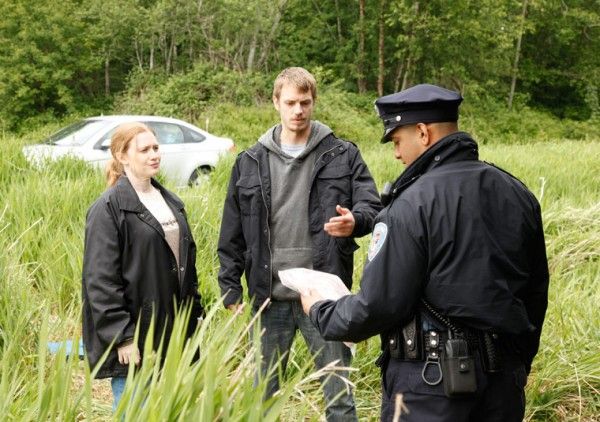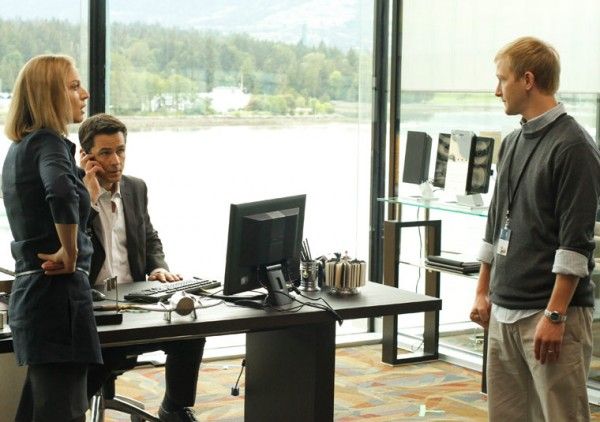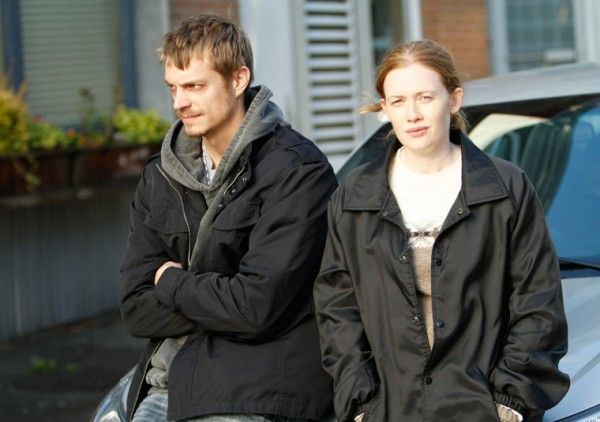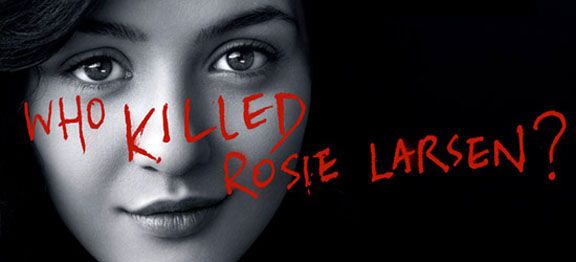Based on the popular Danish television series Forbrydelsen, the AMC drama The Killing tells the story of the murder of a young girl in Seattle and the subsequent police investigation. Tying together three distinct stories, the series follows the detectives assigned to the case, the victim’s grieving family, and the suspects, with each of the 13 episodes covering one day.
When teenager Rosie Larsen (Katie Findlay) is found murdered, Sarah Linden (Mireille Enos) is the lead homicide detective called in to investigate the case, and ex-narc cop Stephen Holder (Joel Kinnaman) becomes her partner on the crime. Seattle’s City Council President, Darren Richmond (Billy Campbell), is in the midst of his campaign for Mayor when Rosie’s body is discovered in the trunk of a campaign vehicle. And, Rosie’s distraught parents, Mitch (Michelle Forbes) and Stan (Brent Sexton), are searching for answers about what happened to their daughter.
During this recent exclusive interview with Collider, executive producer/writer/showrunner Veena Sud (Cold Case) talked about how she adapted the Danish series for an American audience, the appeal of having such a strong female lead character in the center of the series, the importance of finding actors who could carry the weight of this story, her interest in exploring what human nature is capable of, and what an incredibly intense effort it is to create the world of a series, from the ground up. Check out what she had to say after the jump:
Question: How did this come about for you? Were you approached with the idea of remaking this show?
VEENA: They did. Mikkel Bondesen, who owns Fuse Media, had the rights to the Danish series (Forbrydelsen), and they were looking for a show-runner and a writer. Really, it was totally serendipity because I had just left Cold Case and I was looking to develop, and develop for cable. So, when my agent first told me about the material and she said it was called The Killing, my ears perked up and I said, “Oh, my god, yeah. I’m so interested.” And then, I watched the Danish series and just fell in love with it.
Were there specific things that stood out that you wanted to make sure you carried over?
SUD: Yeah. The blueprint of how they told their story was really compelling. The one day is one episode was a great paradigm for me to follow because I like slow-burn storytelling and I wanted to get into the meat of what was going on with the family, what was going on with the cops and the investigation, and what was going on in the political campaign, in seconds, hours and days, as the way to tell the story. I also felt that having a female homicide lead was so original. I talked to the filmmaker of the Danish series and he said that he originally conceived her as a man and then turned her into a woman, but gave her a male drive. I’ve been hungering for that, for so long. Women, especially cops, have been put into this really not great place of having to look a certain way and act a certain way. Except for Cagney and Lacey, and Melissa Leo on Homicide, women very rarely get to be real. So, I was so excited when I saw that, and I wanted to make sure that we did that as well.
Was it your decision to change it from 20 episodes, like the original, to 13 episodes, or was that AMC’s decision?
SUD: It was more about how they structured it. I think the Danish series is 10 episodes per season, so they had a total of 20 episodes to tell the story. I think the creator in Denmark, of Forbrydelsen, chose to tell the story for that amount of time. For us, we’ve got 13 episodes a season, so it’s a different framework.
Is this something that you see continuing for more than one season?
SUD: The thing I love about this story and this type of storytelling is that I don’t have to know the end before I know the beginning. Because we spent so much time in the writer’s room, not even talking about where it goes, but just who the people are in our world, we could find all those unexpected moments and twists and turns that we didn’t even see ourselves. By not foretelling the ending to yourself, as a writer, you’re able to open up the canvas and say, “I’m going to go here. I’m going to go there.” It’s just a little bit more freeing than a stand-alone procedural, where you work backwards from the end.
Knowing that you have to wrap up this mystery by the end of this season, if you do another season of The Killing, would you use all new characters or would the same people solve another crime?
SUD: It’s the open ocean right now because it’s so unique. It’s a really unique way of doing American television. There are a million possibilities. We can stay with the cops. We can introduce new worlds. And, who knows where it will end. Do we want to stay with the family? Who knows? We’ll find it when we get there.
Since both Cold Case and The Killing explore similar subject matter, what is it about crime and the impact it has on families that interests you?
SUD: That was what I loved about Cold Case. We were able to spend time with the victim, and see the victim alive, and see the price on the families and the loved ones in the victim’s world. This is a lot more real estate. We’ve got multiple episodes where we get to tell the story. I am drawn towards it. I think it is the hardest thing in the world. I’m endlessly intrigued by what human nature is capable of, both the horrible things we are capable of and also the heroic things. I’m really interested in exploring that side of human nature.
What was the casting process like, in finding the right people for these roles?
SUD: It was a very, very intense and long casting process because we really had to find the right people who could carry the weight of this story, who had the chops and who had the spirit, where they could bring in so much of their own selves to these characters. So, the casting process took many months. We were able to actually cast the Larsens pretty quickly, in that process. Michelle [Forbes] walked in and we knew that she was Mitch. But, for the role of Sarah Linden, we saw everybody. Everybody wanted this role. Every female actor in town really wanted to play a real woman and be in this drama. It was incredible that all these women were coming in. And then, Mireille [Enos] walked in the door and she was reading the lines that I had written, and I saw her in that field. I was like, “Wow, she’s the one.”
How challenging is it for you, as the show-runner, the executive producer and the writer of some of the episodes?
SUD: It’s a challenge, for sure. My family is not seeing me at all, for probably the next six months, and they haven’t seen me for the last year. I’m really blessed with a lot of great partners, including my writing staff. Being able to rely on the people around me has really helped out.
Do you know how many episodes you will write versus the other writers?
SUD: I wrote the pilot and I wrote the first episode. I’m going to be writing Episode 10, and then maybe co-write the finale of the season with another writer. But, it’s a group process in the writer’s room. Everyone is there. And, I always take a pass at every script, before we go into production. All nine of us in each other’s heads, at this point, and handing each other sentences.
Does it create any pressure to know all of the success that AMC has been having with their original programming, and this being their first crime drama, or does that also give you more confidence, in knowing that’s behind the show?
SUD: Both, definitely. I’m really trying not to think about it. I’m really trying to just keep this internal, and be faithful to the story and the characters, and keep 99.9% of my brain there, serving the story. It’s a great network. It’s the golden network of cable, so it’s totally an honor to be there and tell this story, but I try not to think about anything beyond that.
Do you worry at all about the attention span of viewers, when it comes to them needing to tune in every week for this show because it is such an ongoing story?
SUD: I heard John Wells say something really smart, many years ago. He said, “Assume your audience is really intelligent. Assume that they are really smart, and tell your story that way.” So, for me, it’s about never assuming that they will go away because they’re not entertained. We read novels. We read hundreds of pages of words, when the story is good because we’re willing to stay there. I hope the story is good. I’m going into this venture thinking that the audience is really smart and really wants to hear all the nuances of what we’re saying.
Will you focus on all of the stories every week, or will some episodes focus more on one story than the others?
SUD: It’s going to be a pretty even balance. What’s driving the whole series is a murder investigation. Around the investigation, you’ll see the bigger world of the city politics in Seattle and the smaller world of this family. But, like Traffic, there’s an investigation and all the worlds that are affected by it, so it’s pretty balanced.
Are you going to be providing some answers with each episode, while also bringing up new questions?
SUD: We’re going to mete out answers and mete out more questions, episode by episode, as we go.
Will you have flashbacks to show where these people came from, or will that be revealed in the present?
SUD: It will be in the present. That was a big discussion we had in the writer’s room. We were like, “Do we want to do flashbacks? Do we want to humanize the victim?” In Cold Case, we did that by seeing the victim alive. One of the great challenges I decided on was to be in Sarah’s shoes. The more she grows to feel for this girl, so should the audience. She’s never going to see those flashbacks, so why should we? I’ve heard cops say, and it’s very interesting to me, that when there’s a murder victim, you go through everything. You sometimes get to know them better than their wife knew them, or their children knew them, or their parent knew them. That is what we’re using to fall in love with this girl that we’ll never see alive, except in electronic media or photographs, and at the very beginning when she’s running for her life.
How shocking do you think the reveals about these characters will be for the audience?
SUD: I am endlessly fascinated by this notion that everyone has a secret. Some of our secrets are tiny, small things, and some of them are huge. Given that reality of the human condition, that’s what our characters will go through. There will be some things where you’ll just be like, “What the hell! How the hell did that happen?” And, there will be other things that are so human that you can feel compassionate for this person, even as you feel the pain of the secret being revealed.
How important was the setting to establishing the atmosphere and mood of the show?
SUD: Seattle is absolutely a character in the show. It was really important because I’m hugely affected by physical space. I used to live in New York and now I live in L.A., and somehow I’ve become a different person because of the air and what I see every day, and I think we all do. Creating a world that reflects the inner voyage of our characters was really important. Also, because this isn’t a black and white show, and this isn’t about bad guys and good guys, but it’s about good men being capable of bad things and vice versa, I wanted to be in a city that had contradiction.
Seattle is beautiful. You look at the sky and it’s one of the most beautiful skies in the world, and then there’s the Puget Sound, which will kill you, if you fall into it, but it’s also beautiful. Seattle is a city of contradictions. It’s the most liberal and most literate city in America, and it has Starbucks and [Bill] Gates, but it’s also where the Green River killer hunted women and where the runaway population is just shocking when you walk the streets. Within the same city, there’s darkness and light.
What’s been the most surprising thing about the whole experience of putting this show together and developing it?
SUD: That’s a good question. The most surprising thing to me is what an incredibly intense effort it’s been to create a world from the ground up. I had run a show that had already existed and had been created by the show-runner, Meredith [Stiehm]. It’s a very different experience to come in at ground zero and meet people and assemble the cast and crew. As a group and as a family, we’re creating this world. What’s been so incredibly satisfying and surprising is that, from day one, all of us – Fox, Fuse, AMC, the actors and the writers – are all telling the same story. We’ve all come in wanting to tell the same story, which doesn’t happen.
The Killing premieres April 3




